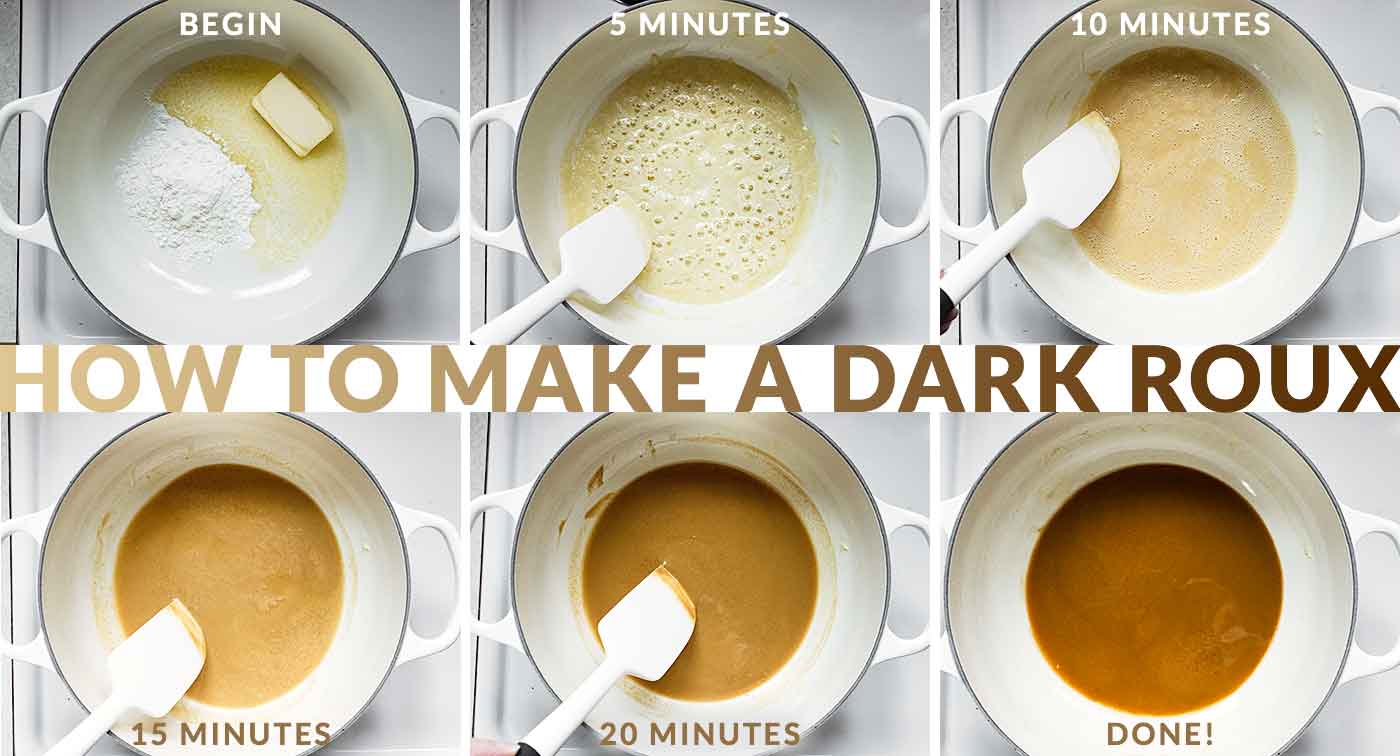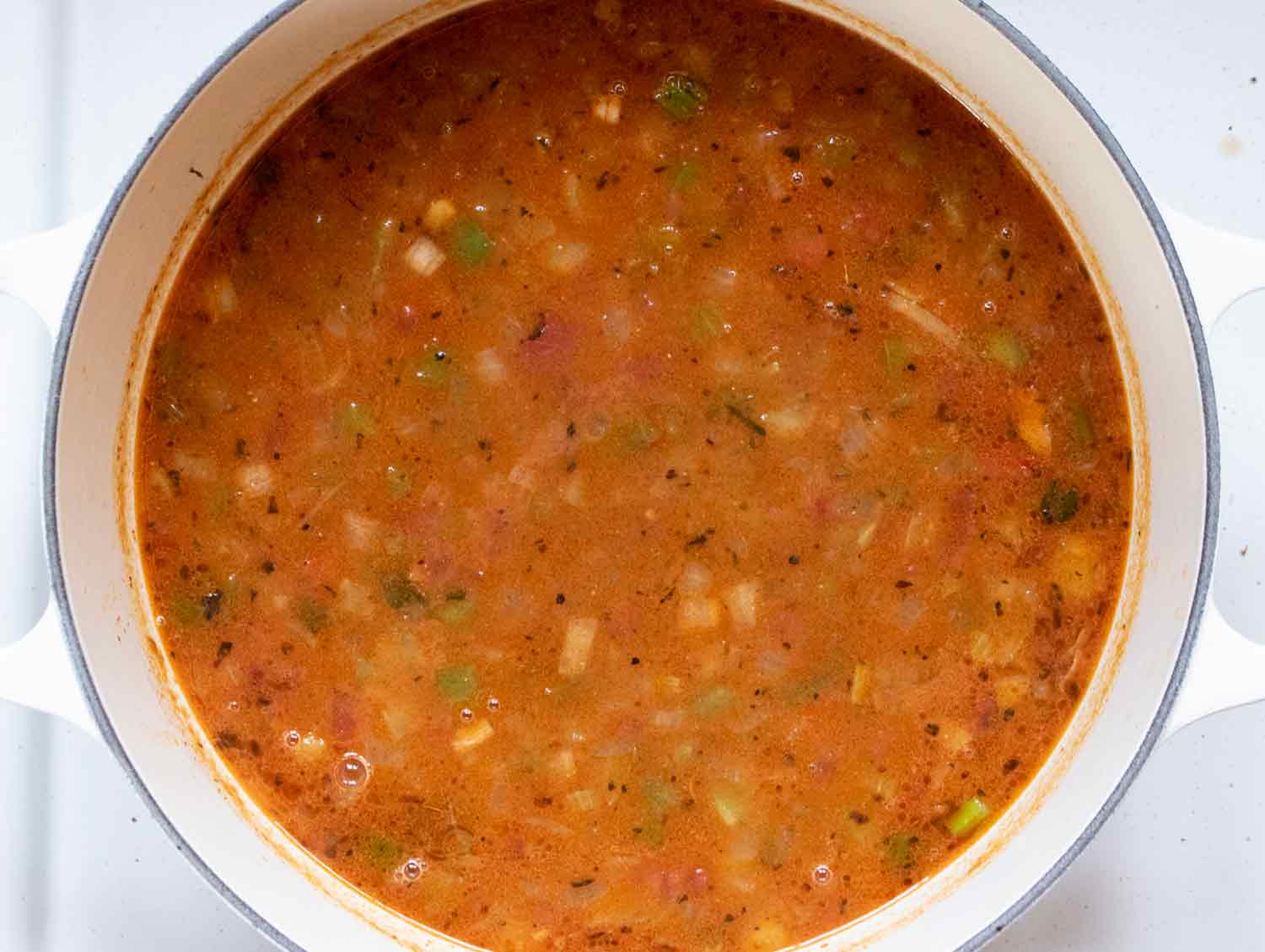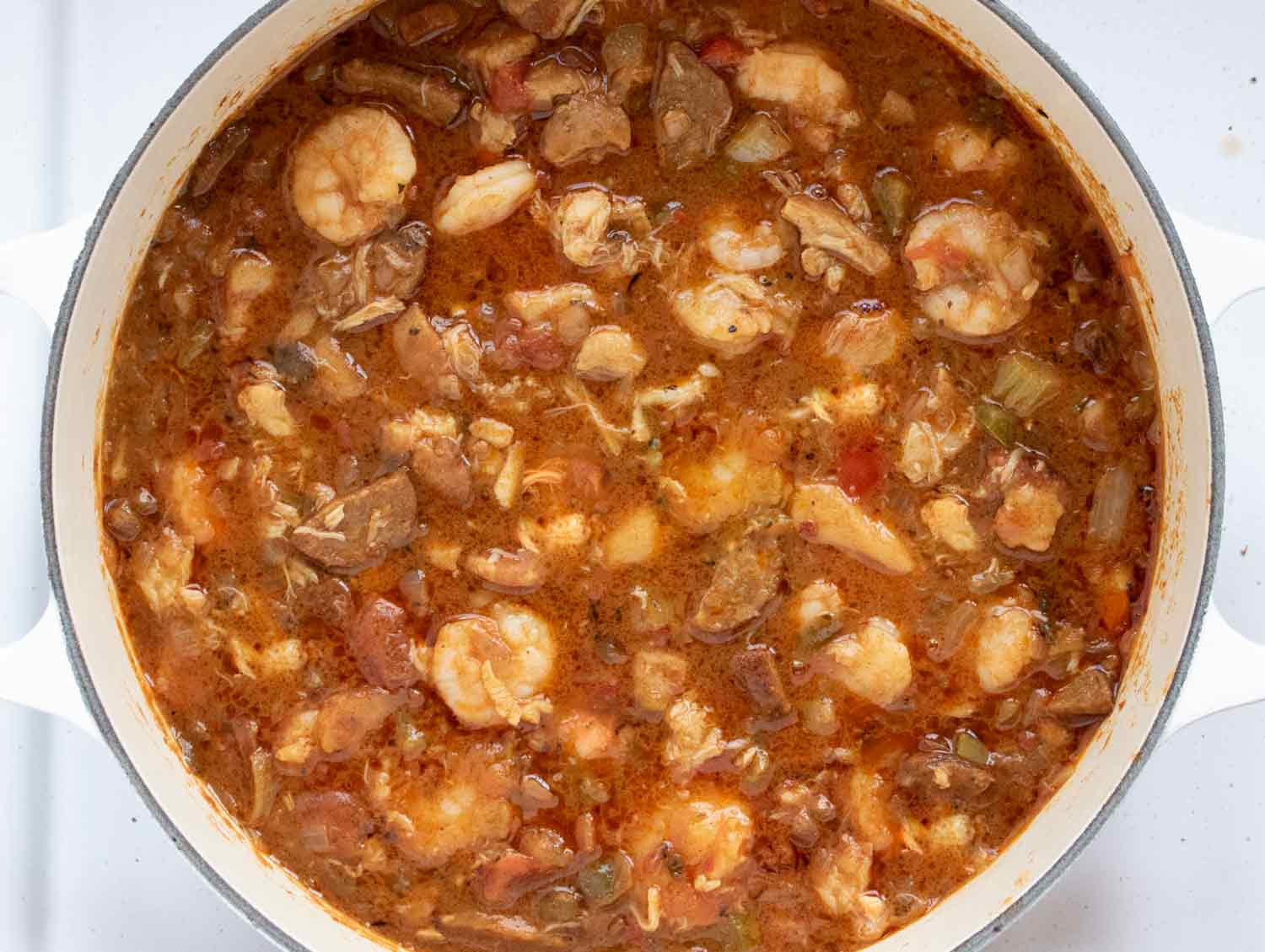A thick, rich gumbo is a welcome meal any time of year, but especially in late winter when Mardi Gras season arrives and we all crave hearty southern comfort food. Creole-spiced Chicken Seafood & Sausage Gumbo with a luxurious dark roux is a delicious weekend cooking project!

I do want to fess up to something up front: there’s no okra in this gumbo. Which, in some Southern households, makes this not gumbo, lol. Gumbo the soup, after all, is thought to be named from “kombo,” another name for the okra plant, brought over from Africa. And okra is traditionally used to thicken Gumbo.
But friends, I’m just not feelin’ the okra. So, I unapologetically leave it out and thicken my chicken seafood sausage gumbo with a classic dark roux and filé powder instead (more on that in a sec).
Speaking of gumbo variations and the question of authenticity, I found this article in the NYT about that very thing. It’s particularly interesting to me as a food blogger, because we’re confronted with the issue of authenticity all the time.
As in, should an American blogger really call their recipe “Thai”-something when traditional, tropical Thai ingredients and methods were not used in the cooking of it? Is it okay to take a recipe and retrofit it to an American kitchen and grocery store, but still call it “Thai”-something in the spirit of homage — or even just as a way to label the flavor palate of the dish?
Anyway, if you’re an aficionado of world cuisines, it’s an interesting read.

Wherever you land on the question of the authenticity of no okra in gumbo, I couldn’t possibly skip over the things that, according to my taste buds, make gumbo gumbo.
First, is the Holy Trinity. This is the Creole/Cajun version of the French mirepoix: onions, celery, and bell peppers. This tasty trio creates the foundation of many Louisiana dishes, including gumbo and jambalaya.
Then, there’s filé powder. Used as a thickening agent, the ground leaves of the sassafras tree add a unique flavor that’s a fascinating cross between root beer and grassy thyme. It makes no sense … and it works.
And it’s wicked effective in adding extra body to the gumbo. If you’re a Northerner, like me, filé might be a tough find locally, but Penzey’s carries it, both online and in-store.
And finally, there’s the dark roux. It’s what gives gumbo that deep, almost gravy-like, Creole-seasoned sauce that envelopes the chicken, seafood and sausage within, to create an impossibly flavorful and crave-worthy soup.

How to make a dark roux for gumbos
First and foremost, it’s important to set aside 30 minutes where you can be in front of the stove without interruption. You can absolutely make dark roux ahead of time, and store it in the fridge until you’re ready to cook up your gumbo. I usually make the roux the day (or weekend) before, which makes the gumbo a much faster dinner to whip up.
- Equipment you’ll need: A heavy bottomed pot or sauce pan, and a whisk or rubber or silicone spatula. While you’ll often see cooks using a whisk in videos or photos, I prefer a spatula, because later in the process, when the threat of burning becomes an issue, a spatula will more efficiently help you move the roux around the pot than a whisk. Although you can certainly use both: use the whisk at the beginning to work the flour into the fat, and switch to the spatula.
- Choose your fat: Although I use butter in my recipe here, you can swap in vegetable oil or bacon drippings at the same quantity.
- Get ready to stir: Unlike risotto, where it’s a bit of exaggerated kitchen lore that you have to stir it continuously or the world as we know it will end, with a dark roux, you do actually have to stir it almost non-stop. Yes, you can break for a 30 seconds here and there, but, especially in the final stages, you have to keep the roux from resting in one spot on the hot surface, where it will singe and burn.
And, here we go!
- Place the pot over medium heat and add your fat and flour. Stir well to create a paste. For the first ten minutes, there will be little activity. If you’re using butter, it will likely foam as the water within boils away. There will be only a little bit of color change, and you should definitely not have spotty color changes (which means you’re not stirring enough!).
- Around the 15 minute mark, you’ll notice a shift in the color from beige to peanut butter. It’s getting there – keep stirring! Use the spatula to thoroughly scrape the roux around the span, leaving no surface untouched. This is where a flexible spatula really comes in handy, because you can see the cleared trails you’ve created in the pan, and know that the roux is being moved sufficiently.
- When the roux starts to reach the coffee-with-cream stage (20 minutes in the photo above), pay extra attention to any signs of burning. My stove is somewhat unreliable — it runs hot — and I have to tweak the heat down in the small stages, from medium to medium-low to prevent burning.
- Keep stirring and scraping!
- As the roux progresses toward chocolate coloring, don’t watch the clock, watch the roux. On my stove, it’s pretty consistent that it takes 30 minutes to reach the chocolate stage, but on yours, it could be quicker or slower. Time doesn’t matter, only the color of the roux, and the fact that it’s unscorched.
- When the roux has reached that deep, dark, rich coloring, remove the pot from the heat temporarily. If I’m making the roux ahead of time, I immediately transfer it to heat-safe bowl to cool for refrigeration. If you’re continuing with the gumbo, but need to pause before adding the vegetables, keep a close eye on the roux in the pot, and give it a frequent stir so it doesn’t burn from the pot’s residual heat.
If you’re making the roux ahead of time, note that, depending on the fat you use, it will probably harden in the fridge. Not a problem. Just bring to room temperature before using (it’s easier to get out of the bowl that way).

How to make Chicken Seafood Sausage Gumbo
Now let’s turn to the Gumbo. Don’t forget to review the full instructions in the recipe card below.
Step 1: Cook the proteins
In a large Dutch oven, cook the sausage until browned and transfer to a bowl. Add the bacon and cook until it has rendered its fat. Layer the chicken among the bacon, and cook until the outsides of the chicken pieces have browned and the bacon has begun to crisp. Remove everything to the bowl with the sausage.

Step 2: Saute the aromatics
Now start building that delish New Orleans flavor! Saute the aromatics with the roux until the onions are soft. Stir in the Creole seasonings and some salt.

Step 3: Simmer the soup
Pour in the stock and bring to a gentle boil. Add the reserved meats and let simmer for about 15 minutes.

Step 4: Finish with the seafood
Reduce heat to low to stop the active bubbling. Stir in the filé. Add the shrimp and crab to the pot, and let warm through until the shrimp is pink, plump, and opaque. Keep the pot on low until ready to serve.

One of the beautiful things about gumbo is that you have a lot of flexibility with the proteins you can choose. I use chicken, shrimp, crab, and Andouille sausage in my gumbo, but you can make a seafood-only gumbo, or with beef short-ribs or ham or duck. Almost anything goes in gumbo, really.
Serve the gumbo over rice — for a healthier take, try my Cauliflower Rice Blend — and don’t forget the Creole seasoning as you cook.

I hope you’ll enjoy this gumbo and the process of making a deeply flavorful roux! If you’d like to explore more Creole cuisine, try my Jambalaya Soup, which is one of my favorite year-round, go-to soups.


Chicken Seafood & Andouille Sausage Gumbo
Ingredients
for the roux:
- 1/4 cup butter, vegetable oil, or bacon drippings
- 1/4 cup all-purpose flour
for the gumbo:
- 1 tablespoon vegetable oil
- 2 links Andouille sausage, about 6 ounces, sliced into half moons
- 2 slices thick cut bacon, chopped into 1/2″ pieces
- 8 ounces chicken breasts, trimmed
- 1 small onion, diced
- 1 green bell pepper, diced
- 2 large ribs celery, diced
- 1 tablespoon Creole seasoning
- 3 cups seafood stock or chicken broth (or a combo*)
- 10-12 ounces shrimp, peeled and deveined
- 8 ounces crab meat
- 2 teaspoons gumbo file
- 4 cups cooked rice
- kosher salt
Instructions
make the roux**:
- It’s important to stay with the pot for the entire half hour, so try to minimize distractions!
- Place a roomy wide-bottomed pot over medium heat (I use my 4 qt. Dutch oven). Add the fat and flour (let the butter melt, if using). Stir into a thick paste using a flat silicone or rubber spatula.
- Continue stirring, keeping the paste moving around the pot. Scrape it up with every pass so that the roux does not rest on the hot surface.
- The roux will eventually begin to thin out a bit and become more fluid. Keep stirring.
- You’ll notice that the roux begins to darken slightly at about the 5 minute mark, and will continue to dark in stages, from beige to peanut butter to chocolate.
- Keep stirring!
- When the roux reaches the peanut butter color stage, pay close attention to the heat: you don’t want it to burn (which is the most common reason for failure).
- Begin edging the heat down, just a little, every three or four minutes (but don’t go below medium-low). Keep stirring!
- Sometime between the 20 and 30 minute mark, the roux will reach the milk chocolate color stage, which is exactly what you want. (Note: however, if the roux seems like it wants to burn, despite reducing the heat, stop immediately — close enough!)
- Remove the pot from the heat and let cool off a bit.
cook the proteins:
- Heat the oil over medium in a saute pan. Add the sausage and cook until browned. Remove to a bowl.
- Add the bacon, and cook until it has rendered its fat. Layer the chicken amongst the bacon, and cook until the outsides of the chicken pieces have browned and the bacon has begun to crisp. Remove everything to the bowl with the sausage. (You no longer need this pan.)
begin building the gumbo:
- Place the pot with the roux back on medium heat. Add the onions, peppers, and celery and stir into the roux. Cook until the veggies are softened, stirring frequently.
- The roux will thicken throughout this process: don’t hesitate to add a splash of broth to keep it loose, if it becomes too dry of a paste.
- Sprinkle the Creole seasoning and a teaspoon of salt over the veggies, and mix well.
- Add the remaining stock and bring to a gentle boil.
- Add the cooked sausage, bacon, and chicken, plus their drippings, and reduce heat to maintain a gentle simmer (medium-low’ish). Cook for 15 minutes.
- Reduce heat to low, and stir in the shrimp, crab meat, and 1 teaspoon of the file. Let the seafood cook through/warm through, until the shrimp is pink and opaque.
- Keep the gumbo on low, until ready to serve.
- Serve with rice, separately. If desired, mix in the other 1 teaspoon of file now, or you can skip and place the container on the table for you guests to mix in as they like.


Carrie
Friday 31st of January 2020
The gumbo was delicious. I doubled the recipe. The only thing I did differently was to add okra. Thank you for the detailed directions.
Nettie Moore
Monday 4th of March 2019
Thank you for contributing! https://parade.com/857991/nettiemoore/celebrate-with-the-best-mardi-gras-recipes/
Lydia
Saturday 2nd of March 2019
This turned out great! I did use a dry roux.....made in the oven. It was easier and not apt to burn. I used spicy chicken sausage, chicken and shrimp. I made your Creole seasoning. It is a must! Thanks for the yummy recipe.....without okra!
SoupAddict
Saturday 2nd of March 2019
The first time I made a dry roux, I was like, this isn’t going to work ... and then it totally did, lol. I’m so pleased you enjoyed the gumbo and the seasoning. Thanks for stopping back to drop a note!